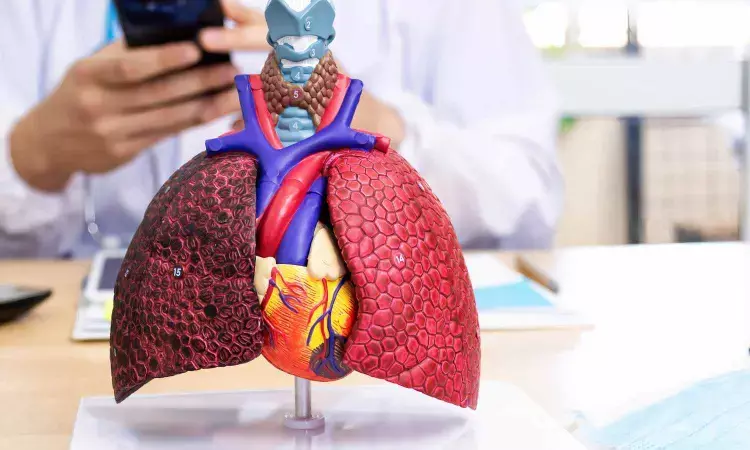- Home
- Medical news & Guidelines
- Anesthesiology
- Cardiology and CTVS
- Critical Care
- Dentistry
- Dermatology
- Diabetes and Endocrinology
- ENT
- Gastroenterology
- Medicine
- Nephrology
- Neurology
- Obstretics-Gynaecology
- Oncology
- Ophthalmology
- Orthopaedics
- Pediatrics-Neonatology
- Psychiatry
- Pulmonology
- Radiology
- Surgery
- Urology
- Laboratory Medicine
- Diet
- Nursing
- Paramedical
- Physiotherapy
- Health news
- Fact Check
- Bone Health Fact Check
- Brain Health Fact Check
- Cancer Related Fact Check
- Child Care Fact Check
- Dental and oral health fact check
- Diabetes and metabolic health fact check
- Diet and Nutrition Fact Check
- Eye and ENT Care Fact Check
- Fitness fact check
- Gut health fact check
- Heart health fact check
- Kidney health fact check
- Medical education fact check
- Men's health fact check
- Respiratory fact check
- Skin and hair care fact check
- Vaccine and Immunization fact check
- Women's health fact check
- AYUSH
- State News
- Andaman and Nicobar Islands
- Andhra Pradesh
- Arunachal Pradesh
- Assam
- Bihar
- Chandigarh
- Chattisgarh
- Dadra and Nagar Haveli
- Daman and Diu
- Delhi
- Goa
- Gujarat
- Haryana
- Himachal Pradesh
- Jammu & Kashmir
- Jharkhand
- Karnataka
- Kerala
- Ladakh
- Lakshadweep
- Madhya Pradesh
- Maharashtra
- Manipur
- Meghalaya
- Mizoram
- Nagaland
- Odisha
- Puducherry
- Punjab
- Rajasthan
- Sikkim
- Tamil Nadu
- Telangana
- Tripura
- Uttar Pradesh
- Uttrakhand
- West Bengal
- Medical Education
- Industry
Novel thrombectomy system safe and feasible in treating acute pulmonary embolism: Study

Late-breaking data from the ENGULF trial showed that a novel dual-action thrombectomy device was effective and safe in treating acute pulmonary embolism (PE). The safety and effectiveness results were presented today as late-breaking science at the Society for Cardiovascular Angiography & Interventions (SCAI) 2024 Scientific Sessions and simultaneously published in JSCAI.
PE is a serious cardiovascular event where a blood clot causes issues with blood flow and oxygen levels in the lungs. It can be life-threatening, with up to 30% of individuals dying within one month of diagnosis. Despite recent advances in therapeutic options, PE still carries a high risk of mortality and morbidity with few FDA-cleared thrombectomy catheters available to physicians.
The ENGULF trial is a prospective, single-arm, first-in-human, safety and feasibility study evaluating a novel embolectomy catheter system for the treatment of acute PE with a steerable and expandable funnel and an internal agitator, the Hēlo™ PE Thrombectomy System. Patients underwent a pre- and 48-hour post-procedural computed tomography (CT) scan. The primary efficacy outcome was the percent difference in the pre-to-post procedural right ventricle–to–left ventricle (RV/LV) ratios. The primary and secondary safety outcomes were all-cause mortality, major life-threatening bleeding, device-related serious adverse events, pulmonary or cardiac injury, and clinical decompensation at 48 hours and 30 days post-procedure.
All 25 patients from eight centers underwent successful embolectomy. The mean RV/LV ratio was 1.53±0.27 at baseline and 1.15±0.18 at 48 hours post-procedure (23.2%±12.81% change). Of note, there were no major adverse events at 48 hours and no deaths at 30 days.
“Although more rigorous studies are needed, RV/LV ratio is the most important predictor of dysfunction and adverse outcomes in acute PE, and it is exciting to see that the RV/LV ratio reduction was just as much as other FDA-approved devices on the market without any large safety concerns in a new first-in-human device,” said Tai Kobayashi, MD, Assistant Professor of Clinical Medicine at Penn Medicine, and lead author of the study. “This technology represents the marriage between large and small-bore embolectomy, which allows for operators to travel through the heart with a smaller catheter but expand a larger funnel that matches the size of the large bore catheters-leaving a smaller footprint and lowering the risk of hemodynamic impact for the patient.”
“For the field of interventional PE therapies to fully reach its promise, continued innovation is needed to optimize our procedural workflows across the wide array of patients affected by this disease,” said Jay Giri MD, MPH, Director of the Cardiovascular Catheterization Laboratories at the Hospital of the University of Pennsylvania, senior author of the study, and national principal investigator of the study. “The ENGULF trial is an important step in this process, demonstrating that a novel, purpose-built PE thrombectomy catheter can achieve excellent results even among its earliest users.”
Reference:
Novel thrombectomy system demonstrates positive safety and feasibility results in treating acute pulmonary embolism, Society for Cardiovascular Angiography and Interventions, Meeting: SCAI 2024 Scientific Sessions.
Dr Kamal Kant Kohli-MBBS, DTCD- a chest specialist with more than 30 years of practice and a flair for writing clinical articles, Dr Kamal Kant Kohli joined Medical Dialogues as a Chief Editor of Medical News. Besides writing articles, as an editor, he proofreads and verifies all the medical content published on Medical Dialogues including those coming from journals, studies,medical conferences,guidelines etc. Email: drkohli@medicaldialogues.in. Contact no. 011-43720751


